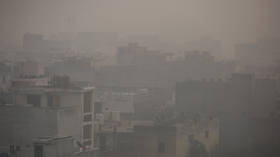Poisonous smog hangs over Delhi after Diwali celebrations (PHOTOS)

The residents of Delhi have woken up to find their city under a blanket of toxic smog, after revelers defied a ban on the use of fireworks as millions celebrated the Hindu festival of lights on Thursday night.
On Friday morning, India’s Air Quality Index surged, reaching 459 on a scale of 500, indicating “severe” air pollution – the highest figure recorded this year. Online resource Waqi.info reported that contamination in the capital on Friday was at least 10 times higher than in London.
The concentration of poisonous particulate matter PM2.5, which can cause cardiovascular and respiratory disease, also hit exceedingly dangerous levels. The World Health Organization considers annual PM2.5 levels above five micrograms as unsafe, yet on Friday, the 20-million-strong metropolis saw its average citywide reading reach 706 micrograms, according to information cited by Reuters. The Indian Express reported that PM2.5 levels measured a whopping 1,553 micrograms at 1am on Friday.
Photos of Delhi shared on Twitter show a dense white smog resting above the capital, with visibility greatly reduced.
#INPICS | 'Itchy throats, watery eyes': Post Diwali, Delhi-NCR air turns 'hazardous'Delhi's air quality expectedly crossed the "hazardous" mark on Diwali evening and the morning after with PM2.5 pollution levels shooting to 774.69 at 3am on Friday pic.twitter.com/1eQEfqENfL
— The Times Of India (@timesofindia) November 5, 2021
A thick layer of smog blankets #Delhi. Overall air quality remains in 'very poor' category' as per the System of Air Quality and Weather Forecasting And Research (SAFAR)-India.Visuals from near Akshardham Temple.(ANI) pic.twitter.com/D3HTzawpk9
— NDTV (@ndtv) November 5, 2021
Delhi has the worst air quality of all world capitals, but Friday’s readings were particularly bad because city residents had celebrated Diwali, the Hindu festival of lights, on Thursday night. Many had defied the ban on fireworks, adding more toxic fumes to air already poisoned by perennial sources.
While the practice is highly restricted, stubble fires – the process of intentionally setting fire to leftover crops to prepare for the next cycle – also contributes to the deadly levels of air pollution at this time of year. The timing of Diwali coincides with that of the fires, as the festival is held at the end of the summer harvest.
Also on rt.com ‘Code red’: UN issues dire warning about climate change, pinning blame ‘unequivocally’ on humansAccording to SAFAR, an air-quality monitoring initiative under the auspices of the federal Ministry of Earth Sciences, stubble fires contribute around 35% of Delhi’s PM2.5 levels.
On Friday, it warned residents not to undertake exercise and to avoid walks. It said dust masks would not offer sufficient protection and advised that all windows should be closed and homes should not be vacuumed, but wet-mopped instead.
If you like this story, share it with a friend!













